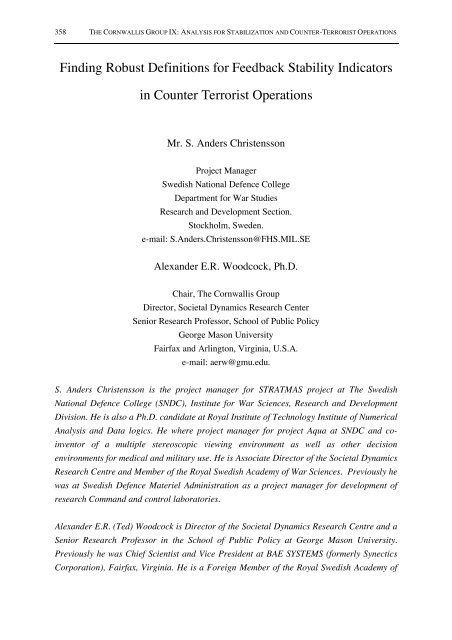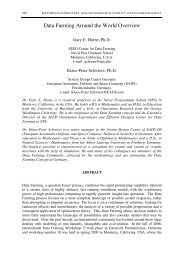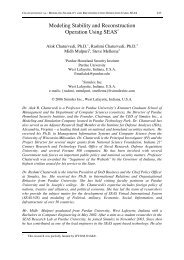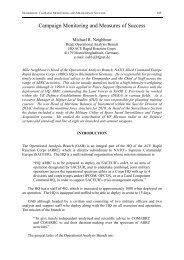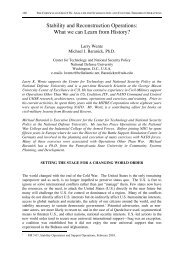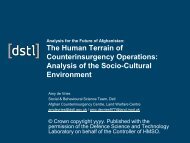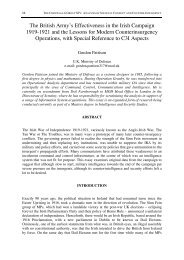Finding Robust Definitions for Feedback Stability ... - Cornwallis Group
Finding Robust Definitions for Feedback Stability ... - Cornwallis Group
Finding Robust Definitions for Feedback Stability ... - Cornwallis Group
Create successful ePaper yourself
Turn your PDF publications into a flip-book with our unique Google optimized e-Paper software.
358 THE CORNWALLIS GROUP IX: ANALYSIS FOR STABILIZATION AND COUNTER-TERRORIST OPERATIONS<strong>Finding</strong> <strong>Robust</strong> <strong>Definitions</strong> <strong>for</strong> <strong>Feedback</strong> <strong>Stability</strong> Indicatorsin Counter Terrorist OperationsMr. S. Anders ChristenssonProject ManagerSwedish National Defence CollegeDepartment <strong>for</strong> War StudiesResearch and Development Section.Stockholm, Sweden.e-mail: S.Anders.Christensson@FHS.MIL.SEAlexander E.R. Woodcock, Ph.D.Chair, The <strong>Cornwallis</strong> <strong>Group</strong>Director, Societal Dynamics Research CenterSenior Research Professor, School of Public PolicyGeorge Mason UniversityFairfax and Arlington, Virginia, U.S.A.e-mail: aerw@gmu.edu.S. Anders Christensson is the project manager <strong>for</strong> STRATMAS project at The SwedishNational Defence College (SNDC), Institute <strong>for</strong> War Sciences, Research and DevelopmentDivision. He is also a Ph.D. candidate at Royal Institute of Technology Institute of NumericalAnalysis and Data logics. He where project manager <strong>for</strong> project Aqua at SNDC and coinventorof a multiple stereoscopic viewing environment as well as other decisionenvironments <strong>for</strong> medical and military use. He is Associate Director of the Societal DynamicsResearch Centre and Member of the Royal Swedish Academy of War Sciences. Previously hewas at Swedish Defence Materiel Administration as a project manager <strong>for</strong> development ofresearch Command and control laboratories.Alexander E.R. (Ted) Woodcock is Director of the Societal Dynamics Research Centre and aSenior Research Professor in the School of Public Policy at George Mason University.Previously he was Chief Scientist and Vice President at BAE SYSTEMS (<strong>for</strong>merly SynecticsCorporation), Fairfax, Virginia. He is a Foreign Member of the Royal Swedish Academy of
CHRISTENSSON AND WOODCOCK: FINDING ROBUST DEFINITIONS FOR FEEDBACK INDICATORS 359War Sciences. Woodcock is also a Guest Professor at the National Defence College,Stockholm, Sweden, and was a Visiting Professor at the Royal Military College of Science,Shrivenham, England <strong>for</strong> 10 years. He is actively involved in the development andimplementation of societal dynamics models of military, political, economic, and otherprocesses <strong>for</strong> the modelling and analysis of low intensity conflict, peace and humanitarianoperations, and related areas. Woodcock is Project Director <strong>for</strong> the Strategic ManagementSystem (STRATMAS) project that is producing a facility that uses genetic algorithms andintelligent automata methods <strong>for</strong> the definition and optimal deployment of civilian andmilitary entities in peace and humanitarian operations. Woodcock is Chair, ProceedingsEditor, and a Founding Member of the <strong>Cornwallis</strong> <strong>Group</strong>. He has a Ph.D. in Biology and anM.Sc. in Biophysics from the University of East Anglia in England, as well as a B.Sc. (withhonours) in Physics from Exeter University in England. He is a Full Member of Sigma Xi.ABSTRACTWhat indicates that the desired end state <strong>for</strong> an operation or mission has been reached? Arethe indicators selected <strong>for</strong> that purpose appropriate to provide an unequivocal output thatsignifies that a particular mission has been accomplished? Can indicators generate numericaloutputs that actually reflect the complex internal dynamics of systems of interest? Inparticular, is it possible to produce robust definitions <strong>for</strong> feedback stability indicators <strong>for</strong> usein Counter Terrorist Operations? What happens when members of a planning staff havedifferent professional, cultural, and ethnic and/or religious backgrounds or national origins?A real need exists <strong>for</strong> operational facilities that can harmonize and integrate such differences.Strategic military planning requires the definition of an End State and the selection ofindicators that can identify when such a condition has been achieved as well as the progressbeing made during execution of an operational plan. In Effect-Based Operations thoseactivities require a direct statement of the nature of the Effective End State and specificationof what effect the planners are striving to create.The paper describes work that is being undertaken at the Swedish National DefenceCollege and elsewhere to develop a new understanding of operational planning processes andto provide enhanced facilities to support those processes. In particular study of the behaviourof dynamical systems can provide useful in<strong>for</strong>mation <strong>for</strong> use as indicators of systembehaviour. Indicators that reflect the properties of models of an operational environment canprovide significant advantages and support to operational planning processes. Developmentand use of the DMSCupol facility to support operational planning as well as the Strategic
360 THE CORNWALLIS GROUP IX: ANALYSIS FOR STABILIZATION AND COUNTER-TERRORIST OPERATIONSManagement System (STRATMAS) to support the analysis and assessment of operationalplan effectiveness and some of the capabilities of those facilities is outlined in the paper.BACKGROUNDThe Swedish Armed Forces are financing development of networked-enabled and focusseddefence capabilities. Related work at the Swedish National Defence College (SNDC) isconcentrated on the development and use of a decision environment to do research on groupdecision-making. The SNDC is setting up experiments in the SNDC laboratory involvingnew software methods, procedures, and hardware in order to produce an increasingunderstanding of military and other processes and how they might be commanded andcontrolled in order to achieve desired outcomes.In order to support these activities and to bring some unity to the various discussions,requirements, and viewpoints, an artist was commissioned in 1996 to provide a rendering ofthe concepts expressed by project scientists in a visual object. The picture created by the artistand scientist team has served as a starting point <strong>for</strong> further discussions on the design of afuture Swedish command post capable of being responsive to new and emerging challenges(Figure 1). This paper reports on some aspects of that work by describing the need <strong>for</strong> robustindicators that can provide in<strong>for</strong>mation on the nature and success of on-going activities andphenomena of interest to military commanders, planners, and analysts. The paper also reportson how production of such indicators can support the ongoing research <strong>for</strong> a networkedenabledSwedish Command Post of the Future based on these and other concepts.
CHRISTENSSON AND WOODCOCK: FINDING ROBUST DEFINITIONS FOR FEEDBACK INDICATORS 361Figure 1: Artist’s concept of the envisioned future Swedish Command Post.INTRODUCTIONThe paper describes ef<strong>for</strong>ts that have focussed on the production of indicators and their use tosupport plan development <strong>for</strong> a range of different types of operation. Indicators can providein<strong>for</strong>mation on the nature of the conditions under which an operation should be undertaken,how well an operation is proceeding, and whether or not a desired end-state <strong>for</strong> the operationhas been achieved. As well as a range of purely military operations, there is also a criticalneed to provide indicators to identify terrorist threats and support counter-terrorist operations.Such indicators would provide insights into the effect of the operation on both the militaryand the wider civilian aspects of the overall conflict environment.Such indicators could be based on, and reflect the nature and constraints imposed by,intelligence data, political resolutions and mandates, and the nature of the mission given to acommander by subordinate political entities. For the purpose of this paper it is generallyassumed that a military commander would be involved in dialogs with political executives inorder to define a future mission and the political indicators. This commander would alsowork with other military <strong>for</strong>ces, and perhaps selected civilian entities (agencies), that have
362 THE CORNWALLIS GROUP IX: ANALYSIS FOR STABILIZATION AND COUNTER-TERRORIST OPERATIONSinterests in achieving a politically-defined End State 1 with indicators.The nature of the indicators used to provide in<strong>for</strong>mation on overall progress is of coursedependant on the nature or phase (such as the US-defined Phases I, II, III, or IV) of an overalloperation, such as counter-terrorist operations that involve actions by both military andcivilian entities. As an example, Phase I activities might involve co-ordinated military andpolitical planning, Phases II and III may involve mainly military actions and relatively highintensity conflict, and Phase IV can be a transition to politically-controlled activities, <strong>for</strong>example. Different indicators might be appropriately used during these different phases toreflect military, civilian, and other activities.In the case of the activities of a strategic military staff, each member would generally usetheir training and experience in different activities and operations to support planningactivities. Such individuals would normally be capable of extrapolating from thoseexperiences to create an appropriate level of understanding and knowledge needed to meetthe needs and problems associated with the new planning environment. Introspective thoughtmay have permitted a review and analysis of prior events and activities that were initiallydifficult to understand and the creation of more appropriate perceptions as well as new levelsof understanding and knowledge.The creation and use of models and simulations such as <strong>for</strong> example the use of SimNettechnology by the University of Central Florida to create a representation of the battle of 73Easting in Operation Desert Storm can provide new insights <strong>for</strong> military planners and others.Computer-based models can provide an environment <strong>for</strong> reviewing actual operations andassessing the impact of changes in the planned deployment and use of military and civilianassets on the overall outcome of those operations.INDICATORS AND THEIR USEIndicators are developed in many organisations and used <strong>for</strong> many different purposes. Eachof those organisations exists in different environments and cultures and work in differentcontexts to solve specific types of problem. It is there<strong>for</strong>e important to develop indicators thatrepresent properties of interest to the organizations themselves. Indicators not <strong>for</strong>1After the <strong>Cornwallis</strong> IX workshop we have learnt that this can be compared with the latest hot topic inmilitary domain namely effect based operations, effect based planning etc.
CHRISTENSSON AND WOODCOCK: FINDING ROBUST DEFINITIONS FOR FEEDBACK INDICATORS 363per<strong>for</strong>mance of the organisation but indicators of the effect an action the organisations isdoing. In this paper two sets of indicators will be outlined. One of these indicators wasdeveloped by The Commission of the European Union to represent levels of conflict, theother presented by The Columbia International Affairs Online to provide an indicator-basedchecklist <strong>for</strong> post-conflict recovery. In<strong>for</strong>mation will also be provided on indicators that arebased on the properties of dynamical systems.Indicators can relate to real or abstract properties or entities. The use of abstract indicatorsmay cause difficulty when attempts are made to use them during rapidly changing crises or inconflict-related actions where there is little time to understand the nature of the constructionsused in the <strong>for</strong>mation of abstract indicators. Military actions in phase II&III may causedisruption in societal processes that do not respond within the timeframe needed if Militarycontrol was of interest. Social processes that take long time to restore during Phase IVoperations.It should be pointed out that some controversy exists with regard to the development anduse of indicators. As an example, Dr. Birger Heldt at the Peace and Conflict Research Centreat Uppsala University claims that according to his research all definitions (with the exclusionof indicators based on the properties of systems dynamics) are generally poor approximationsof reality and are not well suited <strong>for</strong> statistical research analysis. This could create problems<strong>for</strong> those asked to give advice on the development of indicators to support anti-terroristactivities, <strong>for</strong> example. However, if we turn to system sciences and system dynamics thenthose areas may be able to provide advice and guidance on the construction and use ofappropriate sets of indicators.EUROPEAN COMMISSION CHECK-LISTFOR ROOT CAUSES OF CONFLICTThe European Commission checklist on the root causes of conflict is outlined below mayprovide guidance <strong>for</strong> the production of a set of indicators to be used <strong>for</strong> assessing overallpolitical and societal stability and the possibility of conflict and disintegration of existinggovernmental and other structures in countries of interest, <strong>for</strong> example. The EuropeanCommission Check-list identifies the following types of factor:• The Legitimacy of the state:
364 THE CORNWALLIS GROUP IX: ANALYSIS FOR STABILIZATION AND COUNTER-TERRORIST OPERATIONS- Are there proper checks and balances in the political system?- How inclusive is the political/administrative power?- What is the overall level of respect <strong>for</strong> national authorities?- Is corruption widespread?• The Rule of Law:- How strong is the judicial system?- Does unlawful state violence exist?- Does civilian power control security <strong>for</strong>ces?- Does organized crime undermine the country’s stabilities?• The Respect <strong>for</strong> fundamental rights:- Are civilian and political freedom respected?- Are religious and culture rights respected?- Are other human rights respected?• Civil society and media:- Can civil society operate freely and efficiently?- How independent and professional is the media?• Relations between communities and dispute-solving mechanisms:- How good is the relation between identity groups?- Does the state arbitrate over tensions and dispute between communities?- Are there uncontrolled flows of migrants/refugees?• Sound economical management:- How robust is the economy?- How sustainable is the state’s environmental policy?• Social and regional inequalities:- How are social welfare policies addressed?- How are social inequalities tackled?- How are regional disparities tackled?
CHRISTENSSON AND WOODCOCK: FINDING ROBUST DEFINITIONS FOR FEEDBACK INDICATORS 365• Geopolitical situation:- How stable is the region’s geopolitical situation?- Is the state affected by external threats?- Is the state affected by regional stabilities?European Commission checklist <strong>for</strong> root causes of conflict may be used to guide thedevelopment of indicators to represent the scale of conflict in different scenarios. Subjectmatter experts may interpret the checklist when plan is generated. However the componentsof the European Commission checklist are based on European values. There<strong>for</strong>e, care shouldbe taken if the checklist is used to define indicators and compare those indicators withproperties and events in other cultures. Under those circumstances the use of Europeanbasedindicators may be counter-productive since they may suggest actions which would beculturally-inappropriate. Furthermore, it is certain that the checklist needs to be increased inscope in order to provide the basis <strong>for</strong> defining sets of indicators that reflect the outcome ofactivities and processes responsible <strong>for</strong> creating terrorist groups and generating terrorist acts.One can identify in the writing of Thomas Aquinas (1224-74) patterns <strong>for</strong> thought that arereflected in the European Commissions’ checklist. Aquinas states auctoritas principis, in thechecklist this is <strong>for</strong>mulated as legitimacy of the state. According to Professor Jan Hjärpe,University of Lund Sweden, the legitimacy of the leadership of the state involves acceptanceby the overall population of a country or nation of laws, rights, and other entities <strong>for</strong>mulatedand the population accepts that. Such an acceptance is instrumental in conferring power tolead the country or nation on the leader. While such processes are the norm <strong>for</strong> westerndemocracies, that may not be the case <strong>for</strong> Islamic, and perhaps other, countries, and otherdefinitions of legitimacy, perhaps based on religious doctrine, should be developed <strong>for</strong> thosecases.With respect to the Commissions checklist and the ‘Relations between communities anddispute-solving mechanisms’ and ‘uncontrolled flows of migrants/refugees’ categories, it isnecessary to answer the following questions: Is it possible to define an indicator that reflectsthe flows of refugees and displaced persons that could be measured during an operation? Orshould we develop dynamic market indicators that reflect the amount of people that ismoving back and returning over the boarder. Is the spontaneous market indicator a betterindicator of returning refugees <strong>for</strong> Afghanistan then a pure flow of refugees sinceAfghanistan has been involved in war <strong>for</strong> some 30 years and hadn’t time to develop aEuropean relevant indication. Is this relevant if we would like to have indication on
366 THE CORNWALLIS GROUP IX: ANALYSIS FOR STABILIZATION AND COUNTER-TERRORIST OPERATIONS‘Relations between communities and dispute-solving mechanisms’. The country may have amarket but is it possible to measure their market in the same way that European patterns ofbehaviour are measured based on a European understanding of what constitutes a stablemarket? Can we measure refugee flows in Afghanistan in the same way in Europe?We may define indicators but they may have to be divided into hierarchies that arecapable of satisfying the need <strong>for</strong> indicators that reflect basic properties of an environment(such as percent without food, water, shelter and so on) as well as more abstract propertiessuch as disaffection and ethnic violence, disaffection, and political polarization, <strong>for</strong> example.What do this hierarchy look like? Can it be used in strategic/operational planning ofinterventions?COLUMBIA INTERNATIONAL AFFAIRS ONLINEThe Columbia International Affairs Online (CIAO) focuses on post-conflict recoveryanalysis. By stating essential elements in different areas they create in in<strong>for</strong>mational structurethat provides an overview of relevant facts and data <strong>for</strong> a country during crises, post-crisis,post settlements, and long term reconstruction. The CIAO in<strong>for</strong>mational structure appears tobe capable of providing guidance <strong>for</strong> the construction of and definition of indicators <strong>for</strong> therange of activities mentioned above.INDICATORS CAN BE BASED ON THE TYPES OF DYNAMICALBEHAVIOUR EXHIBITED BY SYSTEMS OF INTERESTA very different approach to the construction of indicators draws on an understanding of thenature of dynamical systems, particularly of the types of behaviour exhibited by suchsystems. Definition of indicators based on system behaviour requires the definition of thestate or key variables at work in particular situations. It is evident that even simple dynamicalsystems can generate very elaborate, and even chaotic, patterns of behaviour. The followinglist describes the different types of behaviour that could be exhibited by dynamical systemsunder different conditions.• Damped oscillations where key variables tend toward final fixed values
CHRISTENSSON AND WOODCOCK: FINDING ROBUST DEFINITIONS FOR FEEDBACK INDICATORS 367- Changes are getting smaller, and eventually stop.- In<strong>for</strong>mation mimicking; In<strong>for</strong>mation is <strong>for</strong>gotten. Its not carried away.• Cyclic solutions, repetitive or spiral, sometimes nested or fractal to its solution- Change is still taking place, but is concentrated into small regions.- In<strong>for</strong>mation mimicking; In<strong>for</strong>mation is not communicated.• Chaotic patterns that emerge from the dynamics- They can have periods with pure stochastic pattern and suddenlyswitch to patterns of local regularities.- Change is spreading and is involving all parts of the system.- In<strong>for</strong>mation spreads over large distances. Local interactions generateglobal patterns.• Pure stochastic patterns where finding any order is difficult- Change is spreading sporadically.- In<strong>for</strong>mation is switching between to not be communicating andsuddenly spreading regionally over large distances. Interaction is notinvolving the whole system.If we where to construct indicators we will probably look on direct and indirectindicators. These may behave according to the four archetypes provided by the study ofdynamical systems. Still each indicator that reflects either the European Commission list orthe CIAO checklist has to be defined at planning stage and hopefully be useful as a measur.Isa merge between system dynamics view on European and CIAO checklist possible? If this ispossible when in the planning procedure should we define them? How should the method beconstructed to define a systems dynamic guided indicator <strong>for</strong> European checklist or CIAOchecklist?THE PLANNING PROCEDURE ADOPTED BY THESWEDISH ARMED FORCESThe Swedish Armed Forces have adopted the NATO Guidelines of Operational Planing
368 THE CORNWALLIS GROUP IX: ANALYSIS FOR STABILIZATION AND COUNTER-TERRORIST OPERATIONS(GOP) to support their operational planning activities. This procedure can involve theactivities of strategic planning group(s) who are involved in receiving data and in<strong>for</strong>mation,assessing its validity and using those inputs to address the problems at hand. We can considerthe actions of an overall planning staff involved in analysis, assessment, and plandevelopment. The input data may contain the following generic elements as taking placeinternally, or within some <strong>for</strong>m of notional black box environment.• United Nations resolutions and related in<strong>for</strong>mation, generally received frominternational sources, which defines the need and provides justification <strong>for</strong> themission of interest.• The overall mandate and supporting documents and other materials <strong>for</strong> themission, perhaps provided by national government-level sources in <strong>for</strong> thetroop-providing nations in an international mission.• Data and in<strong>for</strong>mation on the country of interest.• Current and timely Intelligence from the country of interestThese data and in<strong>for</strong>mation elements can be input to the planning staff. In the secureenvironment, the staff might be involved in reading data and in<strong>for</strong>mation inputs, assessing thereliability of those inputs, inferring the meaning of the input, and developing concepts ofoperations that address the essential components of the overall mission. The output from thesecure analysis, assessment, and planning environment could contain the following elements.• Who should do what, if just military resources are used then this ‘who’ shouldcontain military unit names, a specification of what they are assumed to doand the nature of the effect the staff is expecting to accomplish. In order toassess the effect of planned activities it will be necessary to define anappropriate indicator set that permits an assessment of the effectiveness ofplanned activities. The plan might also contain lists of default or back-upentities that would per<strong>for</strong>m specified tasks where primary units were notcapable of action, <strong>for</strong> example.• Where the activity should take place. Location-related in<strong>for</strong>mation should beprovided as a key element of an operational plan in order to insure that all keyoperational areas are covered, and that inappropriate deployment does notcreate errors or vulnerabilities.
CHRISTENSSON AND WOODCOCK: FINDING ROBUST DEFINITIONS FOR FEEDBACK INDICATORS 369• When should the activity take place. Time-related in<strong>for</strong>mation should beprovided in order to insure that the overall plan does not contain any timegaps,or the requirement that entities per<strong>for</strong>m tasks at times and <strong>for</strong> durationsthat are physically reasonable.If a measure of staff per<strong>for</strong>mance is needed it could be obtained from measurements ofthe output from the staff in different ways. One such measure could involve the time taken toproduce an order that contains who, what, where, and when list? Another per<strong>for</strong>mancemeasure could be based on an assessment of the completeness of such lists. A third measurecould reflect the relevance of outgoing list seen from a military theoretic point of view.Againwe assume military resource are dominating the scenario. If one could measure onecould state questions if best of military practice is considered? Given a fix repertoire ofscenarios and background data the staff can have procedural support or not and this willreflect the out coming result of there planning activities.If we are able to look inside the ‘black box’ that we have created to contain the staffplanning activities, we would be able to identify process, procedures, and procedural productsassociated with planning staff activities. The methods actually employed by the staff mighteither hinder or facilitate plan production. Procedural planning products would provide coordinatedlists of who does what, where, and when. These planning products would bedefined according to the NATO GOP version specified in 1999 (used because that versionwas available as an open-source document). We argue here that these procedural planningproducts are the items that the staffs have to develop because otherwise the staffs have notunderstood the meaning and context of the mission. The strongest use of the proceduralplanning products is to mediate the staff awareness of the content of the orders, how thoseorders should be <strong>for</strong>mulated and the indication of effects.THE TIME PLANNING PERSPECTIVE, ROBUST PLANNING,AND DIRECT AND INDIRECT INDICATOR REQUIREMENTSThe staff in the black box, military officers (as well as diplomats, non-government officers,and international based organisational officers under appropriate circumstances) may betasked to develop plans to intervene in an appointed country or to undertake other types ofmission. By tasking members of a staff to co-operate in the development of a plan they arestruggling with many different problems at the same time.
370 THE CORNWALLIS GROUP IX: ANALYSIS FOR STABILIZATION AND COUNTER-TERRORIST OPERATIONSEach of the staff members and other participants brings their own perceptions, training,and experience to the planning process. As a result they will possess different internal modelsand perceptions of external processes and could make different projections about futurebehaviour. As an example, we will describe possible planning and future assessmentactivities of a notional planning group <strong>for</strong>med from six individuals with different experiencesand training who have been asked to asses the levels of future violence over the next 1 to 2years in an notional area of operations. Figure 2 shoes the results of this request and displaysthe superposition of the time traces of the six individual patterns of projected violence <strong>for</strong>medas a series of colour-coded dots. In this case, the number of dots has been reduced to aminimum in order to prevent over-crowding of the illustration.Figure 2 shows the perception of the level of violence at different times during a futureoperation of six notional individuals involved in the operational planning process. The sixplanning staff members are involved in activities that are trying to sort out the type of endstate to which they should aim as well as the critical issues or centres of gravity that can beresolved in order to achieve the desired end state. Most if not all of the planners may haveexperiences in the planning and execution of similar operations. Such experiences mayrepresent the best knowledge available to support the planning <strong>for</strong> the subject operation. As ateam, it will be necessary to build common ground and exchange experiences and apply theirjoint knowledge and understanding to the mission operational mission planning through theidentification of an event trail through which they define a desired series of events aimed atachieving a specified end state.Figure 2: Strategic military group modelling of a plan.
CHRISTENSSON AND WOODCOCK: FINDING ROBUST DEFINITIONS FOR FEEDBACK INDICATORS 371These events are matched to their knowledge, experiences, intelligence and logic. This isillustrated by the trail of dots shown in Figure 2 that are linked to the combined experiencesand logic possessed by the team. If the team members where to choose and define indicatorsthat represent violence levels then their resulting consensus might be plotted like the coloureddot-trail of events along the time axis indicating defined events that were needed to happenduring the execution of an operational plan. The levels shown by indicators representing theactual level of violence associated with a societal system of interest, <strong>for</strong> example, could beestimated at specific times and reported to the planning staff in order to provide estimates ofthe success achieved in plan execution.Following the patterns created by the coloured dots on the time axis (Figure 2) it ispossible to observe that each staff member may be extrapolating from current activities topossible future events without the use of feed-back knowledge that could be used to supportplan modification and enhancement. It is possible that the combination of the experiences,internal world models, and perceptions of the six notional planning staff members might leadto the production of a more robust plan that could provide contingencies <strong>for</strong> a wider range ofpossibilities than a plan produced by a single individual in isolation. The planning processcould be further enhanced by the construction of facilities that support the definition and useof indicators that provide feedback in<strong>for</strong>mation in a precise and timely manner and supportplan modification, <strong>for</strong> example.It is also necessary to consider the two different mechanisms of direct and indirectinteraction caused by an intended, planned tasks and the effects that they will cause. Differentactivities and processes should support caused effect in order to support the development of asuite of indicators that can provide sufficiently comprehensive operationally basedin<strong>for</strong>mation to a planning staff. The STRATMAS facility, mentioned below, uses both directindicators (such as the percentage without food, water, and shelter) as well as relativelyindirect indicators such as disaffection and level of ethnic polarization) to provide feedbackto its users.Direct and indirect interaction mechanisms may require the definition of different typesof indicator in order to provide appropriate levels of in<strong>for</strong>mation to a planning staff, <strong>for</strong>example. Direct interactions occur when a task directly causes an event concern. An indirectinteraction appears when a task is indirectly leads to an event, through its interaction andimpact on other factors that in turn will interact and produce an event of concern. Ourplanning team may tend to see fewer effects coming from indirect interactions than directinteractions effects. Indirect interactions effects may occur when blue soldiers take action onresident population and the population is responding in a violence level. This raise in
372 THE CORNWALLIS GROUP IX: ANALYSIS FOR STABILIZATION AND COUNTER-TERRORIST OPERATIONSviolence level may produce a growth environment <strong>for</strong> terrorism. To identify an individual asa terrorist based on his or her pattern of behaviour be<strong>for</strong>e they have undertaking a terroristevent can be extremely difficult. Even more difficult is the task of unravelling the reasonswhy a particular individual might actually be a terrorist. Such reasons may be based onevents only indirectly interactions and linked to other mechanisms. Direct interactions suchas interactions between soldiers on a battlefield are easier to develop tactics <strong>for</strong>.If we do not see the result of indirect interactions as clearly as we do the results of directinteraction, we mostly need support to infer the indirect interaction. This support needs to bedeveloped. We argue that the staffs has to consider in the future planning processes moreindirect interaction indicators as well as the direct interactions indicators in stated End State,the Centre of Gravity, the Lines of Operations or operational functions, the Phasing of tasksand the Decision Points that they define.There is a need <strong>for</strong> notational systems that capture the dynamics of political and othertypes of systems and generate in<strong>for</strong>mation that could be readily parsed and analyzed by manand/or machines. This notational system should support a user when (s)he experiments withdirect and indirect interactions either alone or in groups. There is also a need to identify whoshould have the responsibility to define the indicators needed to support operational planningand assessment. Should this task be undertaken by political executives, by strategic militaryexecutives, or by specialists in political science based on their research on failing states andrelated issues?Furthermore, is there a possible relation between the indicators that the political executivebranch is using and those that a strategic military planning staff could use? If so what wouldthose indicators look like? If it is the strategic planners who construct the plan they alsoshould be directly involved in defining the indicators, as well as their dimensions and scale.These tasks demand the attention of a skilled staff who, ideally, might make choices from apallet of indicators already constructed by analysts and other specialists based on extensiveresearch and practical experience. These matters are of continuing interest.DEVELOPING AN INTERVENTION PLANAs mentioned above SNDC adopted the NATO Guidelines of Operational Planning (GOP) tosupport her operational planning activities. In doing so Sweden discovered that the procedurelacked mechanisms to trace the internal processes (which we refer to here as ‘black box’
CHRISTENSSON AND WOODCOCK: FINDING ROBUST DEFINITIONS FOR FEEDBACK INDICATORS 373processes) used by a staff when developing planning products. SNDC then undertook studiesof the nature and location of this demand in the overall operational process. These studiesshowed that the NATO Guidelines of Operational Planning was a procedure that neededadditional software support. Identified needs included the following.• The processes and procedures <strong>for</strong> assigning planning tasks as well as theproduct or output created by those tasks should be able to be stored, retrieved,altered, and stored again.• The product and in<strong>for</strong>mation on the context within which the plan wasdeveloped as well as all relevant planning products created by a planning staffshould be able to used on-demand in a distributed, group-oriented, manner.The 1999 version of the NATO GOP has been interpreted according to SNDC strategicand operational procedures. Although this was well documented it was not really sufficient toSNDC needs. This led to requests to industry in order to identify the ways in whichindustrial processes trace who-does-what? when? where? how? and why? within an overallorganization. This request led to the identification of the Quality Function Deployment(QFD 2 ) methodology as a possible solution to the needs identified above. The QFDmethodology has been demonstrated both to cut costs and to reduce the length of the time-tomarketperiod of manufactured goods. The Defence College has supported research activitiesthat interfaced the QFD technology with the NATO GOP procedure and provided enhancedfunctional capabilities <strong>for</strong> the overall entity. These activities led to the production of theDMSCupol facility, which is described in more detail below.COURSES OF ACTION ARE PRODUCED IN DMSCUPOLDMSCupol consists of many interacting components. The output of some of thosecapabilities that are responsible <strong>for</strong> generating the schema <strong>for</strong> the operational planningprocess of DMSCupol are illustrated in Figure 3. All DMSCupol documents are stored withina folder hierarchy, elements of which are shown in Figure 4. The core of the facility is anetworked client server-based document management system (DMS). All storage, retrieval,and on-line and off-line functional capabilities are interfaced through an XML-based schema<strong>for</strong>mat.2QFD was also used to structure The Defence of the Homeland process.
374 THE CORNWALLIS GROUP IX: ANALYSIS FOR STABILIZATION AND COUNTER-TERRORIST OPERATIONSFigure 3: DMSCupol. The operational planning schema is shown on the right-handside of the illustration.The document management systems of DMSCupol is interfaced to various types of MSOffice software such as Visio, Word, PowerPoint, and Excel. A staff member orgroup of staff members may draw the structure of a plan with MS Visio. The NATOsymbols are added as templates in order to support user activities during their development ofCourses of Action (COA) in support of overall operational plan development. Figure 5 showsa COA score. Each NATO symbol appearing in the COA is interfaced with XML-basedroutines in order to link all produced documents to the overall COA document.
CHRISTENSSON AND WOODCOCK: FINDING ROBUST DEFINITIONS FOR FEEDBACK INDICATORS 375Figure 4: DMS Folder hierarchy.Figure 5: A COA Operational Score.ALL PLANNING DOCUMENTS ARE MANAGEDTHROUGH DMSCUPOLThe document management system in DMSCupol administrates all associated documentsthrough its drawing capabilities, which are functionally supported by MS Visio. The choiceof MS Visio was made because it was the drawing tool most widely used by topexecutives. The user draws a COA Score with MS Visio and through XML tagging caninter-link all documents and store all components in a database. Adequate data handlingcapabilities can be provided by use of the IBM Domino-server. That server can handleseveral thousands of simultaneous users involved in producing and up- or down-loadingdocuments from remote plat<strong>for</strong>ms.The Document Management System (DMS) was developed initially in response to thedemands of a construction firm and had been used <strong>for</strong> several years with several thousand ofsimultaneous users that uses and administrating 3-4000 separate projects all over the world.DMS has successfully interfaced MS Word, PowerPoint, Excel, map-based or BLOBbasedsoftware in the production of documents <strong>for</strong> the construction industry. Analysis of theDMS facility demonstrated significant potential <strong>for</strong> its use as a basis <strong>for</strong> production of thefacilities needed to support Swedish operational planning activities. The Swedish NationalDefence College, together with the vendor (Develop Europe AB), interfaced the NATO GOPprocedure with QFD and the DMS system.Figure 3 shows a NATO GOP structure that supports the composition of the processrelatedproducts that a staff should generate during a planning activity. Figure 4 presents the
376 THE CORNWALLIS GROUP IX: ANALYSIS FOR STABILIZATION AND COUNTER-TERRORIST OPERATIONSfolder hierarchy that is generated by the procedure. Here it is possible to load up and providetemplates to support staff members during their planning process activities. Figure 5 shows aspecified operational planning product linked to the operational scenario. It provides arepresentation of specified NATO planning products, the specified operational End State, theCentre of Gravity, Lines of Operations, Decisive Points and the appropriate Phasing of thecomplete set of planned actions.In summary, all documents developed staff members are linked to the Operational Score.Under these circumstances, a commander is able to get a quick orientation of all the resourcesin the same way that an orchestral conductor can get an overview by looking at a musicalscore. A commander and his (or her) staff can easily determine the total production ofdocuments produced by the planning process by just clicking on symbols in the OperationalScore. A staff member can either work on-line or submit his documents in batches to theDMSCupol system. Although these capabilities are very helpful to some extent, experiencehas shown that additional support <strong>for</strong> the overall planning process is needed.As the planning procedure matures, the staff can begin to identify the nature of theindicators needed to provide in<strong>for</strong>mation on the success of planned operations. The indicatorsthat later will signify the achievement Decisive Point objectives during an execution of theOPPLAN are identified during the Course Of Action development stage and can be put intotheir appropriate location in DMSCupol. Figure 6, shows a screen shot where the indicatorsare defined or selected from a candidate list. A Staff could pick as many indicators needed orjust use specific key indicators and link them directly to the appropriate Decisive Points inthe DMSCupol system. Multiple viewing capabilities have been introduced in order toprovide a better view of the overall COA within DMSCupol <strong>for</strong> the Commander, planningstaff, and others.
CHRISTENSSON AND WOODCOCK: FINDING ROBUST DEFINITIONS FOR FEEDBACK INDICATORS 377Figure 6: A DMSCupol screen shot, showing the editor and indicators definitioncapabilities.THE DECISION-MAKING MATRIX 3, DM3, CONTAINSLISTS OF INDICATORSOne view of the results of the operational planning activities is provided, as described above,by inspection of the Operational Score. Another view can be provided by inspection of theDM 3 Matrix (Figure 7). Construction of the DM3 matrix involved ordering the COA datainto rows and columns. At the left of the Figure, the column contains all the What’s to do,consisting of the staffs’ perceived and complete list of operational objectives that has to beundertaken. Comparing this with NATO procedure support tool 3 provided guidance on the3TOPFAS (Tool <strong>for</strong> Operational Planning, Force Activation and Simulation) Author Håkon Thuve Chief,Operations & Logistics Planning Branch Operations Research Division NATO C3 Agency P.O. Box 1742501 CD The Hague, Netherlands. Phone: +31-(0)70-314-2313 Fax: +31-(0)70-314-2158 e-mail:‘thuve@nc3a.nato.int
378 THE CORNWALLIS GROUP IX: ANALYSIS FOR STABILIZATION AND COUNTER-TERRORIST OPERATIONSsorting of three different defined objectives that had to be achieved, <strong>for</strong> example. The upperrow of the DM3 matrix provides a list of all the How’s that would be developed by the staffofficers during the planning process.Figure 7: The DM3 matrix <strong>for</strong> DMSCupol.When structured in this way, the DM3 matrix gives a overview <strong>for</strong> the commander whereit is possible to determine in a rapid and comprehensive manner the stated objectives(presented in the left-hand column of the matrix) and the staff analysis and development ofthe How’s to achieve those objectives(presented in the upper row of the matrix). This isindicated by all the dots in the matrix. The dot signifies a Why and its colour indicates theimportance of that Why. The dot is relating a What, (left-hand column) to a specific How,(located in the upper row of the matrix.).Inspection of the clustering of all the (colour-coded) dots in the DM3 matrix permits acommander and his staff to identify the possible concentration of dots in relation toachievement of specific objectives. Such a review might lead to that What, and perhaps noother What objectives, receiving increased attention. Or if inspection reveals that a listedobjective does not have a Why linked to a How it is possible to question why was the task (theHow) listed and to provide additional in<strong>for</strong>mation as needed.By having two views or perspectives of all the What’s to do comparable to all the How’sto conduct and the linking of the What’s to appropriate How’s with the use of the dots in the
CHRISTENSSON AND WOODCOCK: FINDING ROBUST DEFINITIONS FOR FEEDBACK INDICATORS 379matrix, it is possible to provide an overview that permits one to see Why a What to do has itsHow to do it. A user can use the overview of the Operational Score and the DM3 Matrix todevelop a better understanding through the use of two perspectives on the same data than ifonly presented with a single perspective.During the group modelling procedure in the staff when the shifting between COA scoreand the DM3 view, Figure 7, it may be possible <strong>for</strong> the staff to define indicators that signifythat a specific task is producing the required effect. By placing the indicator on the row justunder the rows of all the How’s, in the upper portion of the matrix we give an overview <strong>for</strong>the staff when they are moving over from Operational Score (Figure 5) to the DM3 matrix(Figure 7). By defining and placing the indicators in the DM 3 matrix, Figure 7, it is possibleto create a control panel <strong>for</strong> execution of operational plans. In this panel data from the battlerhythms are reported as shift in colours of the indicators as the input data increase or decreasein value reflecting changes in the operational environment, <strong>for</strong> example.COMBINED DATA FROM DEVELOPED COA ANDTHE INDICATORS TO THE SIMULATIONDevelopment of <strong>for</strong>mal models of situations of interest requires the development of anappropriate set of indicators that are linked to, or represent, the key processes and structuresof the model. Production of an appropriate set of indicators (perhaps based on the EuropeanCommission list, CAIO-derived in<strong>for</strong>mation or in<strong>for</strong>mation from other sources) couldsupport activities aimed at validating the model processes and verifying the model output.Use of an appropriately validated and verified model can support operational planning bypermitting analysis and assessment of the impact of different plans or plan elements on theoverall plan-directed outcome. Models can be used <strong>for</strong> the following types of activity duringthe planning process.• Open simulation in order to support war gaming to determine theeffectiveness of options selected during plan development.• Closed simulations in order to support identification and selection of options<strong>for</strong> planning and/or execution within the operational environment by acommander.
380 THE CORNWALLIS GROUP IX: ANALYSIS FOR STABILIZATION AND COUNTER-TERRORIST OPERATIONS• Evolutionary simulations to examine the available range of friendly and/orhostile <strong>for</strong>ce options or to undertake some <strong>for</strong>m of stability analysis.Figure 8: A map of Afghanistan generated by the STRATMAS facility showing themap-based presentation of percent victims of crime indicator data.Figure 8 shows the output from the <strong>for</strong>mal models contained within the StrategicManagement System (STRATMAS) that was generated during a post-conflict stabilizationstudy of Afghanistan (described in more detail below). In this case, the map-based display ofpercent of individuals impacted by crime throughout the nation. Indication of hot-spotsreflecting high levels of criminal activity could identify a need <strong>for</strong> changes in operationaltactics and strategies <strong>for</strong> the deployment of police and other law en<strong>for</strong>cement assets, <strong>for</strong>example, in order to reduce crime levels in identified areas. Other indicators in STRATMASreflect levels of other properties of the overall society and in<strong>for</strong>mation provided by thoseindicators could be used to warn <strong>for</strong> the need to address other challenges.METHODOLOGICAL RESEARCH AND AN AFGHANISTANEXERCISE-DRIVEN STUDYThe Strategic Management System (STRATMAS) Phase III was developed <strong>for</strong> the SwedishNational Defence College and the United States Joint Staff (J8) by a small international team
CHRISTENSSON AND WOODCOCK: FINDING ROBUST DEFINITIONS FOR FEEDBACK INDICATORS 381led by George Mason University School of Public Policy. STRATMAS was used to support apost-conflict stabilization study of Afghanistan in the Aquarium facility at the SwedishNational Defence College, Stockholm, Sweden in January 2003 (Figure 9). The Aquariumfacility is the Swedish National Command and Control and Crisis Management Testbed.Figure 9: The senior political leadership, <strong>for</strong>ce commander, and planning staff <strong>for</strong> thePost-Conflict Stabilization Exercise on Afghanistan in session at the Aquariumfacility at the Swedish National Defence College.STRATMAS III provided a realistic representation of a notional societal environment inAfghanistan within which peace and humanitarian operations could take place. STRATMASgeneratedsocietal data were displayed in both map-based, Figure 8 above, and graphical<strong>for</strong>mats, and used to set the scene <strong>for</strong> the study participants and to provide a basis <strong>for</strong>assessing the effectiveness of their actions that involved planning <strong>for</strong> the deployment ofmilitary <strong>for</strong>ces and civilian entities to support post-conflict stabilization. The Post-ConflictStabilization Study of Afghanistan involved DMSCupol planning activities as well asSTRATMAS-supported analysis, assessment, and planning activities <strong>for</strong> military <strong>for</strong>ces andcivilian entities. Two consecutive notional scenarios were used in the post-conflict study.• Phase 1: Deployment of the Afghanistan Emergency Force (AFGEM). Thefirst scenario described the trans<strong>for</strong>mation from a post-conflict situation
382 THE CORNWALLIS GROUP IX: ANALYSIS FOR STABILIZATION AND COUNTER-TERRORIST OPERATIONSinvolving high levels of violence to intermediate levels of violence. Itinvolved the deployment of the notional Afghanistan Emergency Force(AFGEM) involving some 60,000 individuals under UN authority as well ascivilian humanitarian entities.• Phase 2: Deployment of the Afghanistan Recovery and Stabilization Force(AFGRES). The second scenario considered further trans<strong>for</strong>mations to lowviolence level conditions where societal reconstruction and developmentbecome possible. A year after deployment of AFGEM, the UN SecurityCouncil notionally authorized deployment the Afghanistan Recovery andStabilization Force (AFGRES) with a maximum <strong>for</strong>ce strength of 25,000, inorder to support the recovery and long-term stabilization of the country.The senior political leadership group in the Study consisted a retired United StatesAmbassador, currently working in the Peace Operations Policy Program at the School ofPublic Policy at George Mason University, as well as another senior United States civilian.The group provided strategic political guidance to the Study participants. A Swedish MajorGeneral played the role of the overall Force Commander <strong>for</strong> the Study. The General with thestaff assistance of a Swedish Lieutenant Colonel used the political guidance and otherin<strong>for</strong>mation to provide the Commander’s Intent and planning guidance <strong>for</strong> the Planning Staff.The Study Planning Staff, consisting of military and civilian personnel, prepared 90-dayaction plans to represent the initial response to the conditions in Afghanistan associated witheach scenario. The impact of the plans, which were made in DMSCupol, was then determinedwith the aid of the STRATMAS facility. Data on a series of key societal variables, displayedin map-based and textual <strong>for</strong>mats, indicated significant reductions in violence levels and theamelioration of the overall societal conditions resulting from deployment of AFGEM andAFGRES and the civilian entities.Activities during the study in January 2003 at the National Defence College in Stockholmclearly showed that joint use of DMSCupol and STRATMAS permitted development of avery significant understanding of the problems associated with post-conflict stabilization inAfghanistan. Development of that understanding was greatly enhanced by the fact that thestudy took place in the Aquarium facility. Taken together, DMSCupol and STRATMASimplemented within the Aquarium, provide a unique and proven support capability <strong>for</strong>studies and exercises involving post-conflict stabilization and related activities. DMSCupoland STRATMAS has been designated by the Swedish authorities as the software system as‘center of gravity’ <strong>for</strong> future development of the Aquarium.
CHRISTENSSON AND WOODCOCK: FINDING ROBUST DEFINITIONS FOR FEEDBACK INDICATORS 383CONCLUSIONSIt is not immediately evident how indicators should be developed to provide in<strong>for</strong>mation onthe status of complicated, or perhaps even simple, scenarios. Some guidance on appropriatepolitical, economic, and other types properties that may provide a basis <strong>for</strong> the <strong>for</strong>mation ofof indicators could come from such sources as the European Commission checklist or theColumbia International Affairs website. Other guidance can come from a study of thedynamical properties of a system or systems of interest. In this case interest is placed on thedynamics of the types of behaviour that may occur rather than on specific numbers associatedwith the properties chosen as indicators.The Swedish National Defence College has developed the NATO GOP procedure thatembeds indicators with the DMSCupol software environment. This facility can be interfacedwith <strong>for</strong>mal computer-based simulations. Such facilities have been tested during a postconflictstabilization study of Afghanistan held at the Swedish National Defence College inJanuary 2003. This study demonstrated that indicators could be used with benefit to identifyconditions that emerge in response to defined operational plans. The studies also pointed outthe need to develop additional sets of indicators that represented additional properties of theoperational environment as well as the need to undertake model and indicator validation andverification activities in order to create a trusted planning environment.FUTURE WORKFuture work will focus on interfacing systems that export data from DMSCupol and importdata and in<strong>for</strong>mation to a Scenario Generator. Output from the Scenario Generator will thenbe sent to a client server-based version of the Strategic Management System (STRATMAS).These new capabilities would permit a staff to be distributed close to an operational or otherfunctional area as well as permitting the staff to carry detailed modeling, analysis, andassessment activities with STRATMAS, perhaps located at a remote location.Future work will also focus on providing the ability to support reporting on processes andactivities that are actually taking place at operational and other locations and providing that
384 THE CORNWALLIS GROUP IX: ANALYSIS FOR STABILIZATION AND COUNTER-TERRORIST OPERATIONSin<strong>for</strong>mation in a timely and precise manner to support modeling, analysis, and assessmentrelatedactivities.At the Swedish National Defence College we will also interface the output generated bySTRATMAS and other model-based facilities to custom-built stereoscopic presentationfacilities. Use of those facilities will enhance the ability of a staff to obtain an appropriatelydetailed overview of new and emerging structures in the societal conflict environment.REFERENCES1. http://europa.eu.int/comm/external_relations/cpcm/cp/list.htm, 2004.2. http://www.ciaonet.org/frame/aboutfrm.html, 2004.3. Wolfram, Stephen, 2002. A New Kind Of Science, Wolfram Media, Inc. ISBN 1-57955-088-8.4. NATO Guidelines of Operational Planing, 19995. Cohen, Lou. Quality Function Deployment, How to Make OFD Work <strong>for</strong> You. Engineering ProcessImprovement Series, Addison Wesley Longman, ISBN 0-201-63330-26. Koza, John R., 1988. Genetic Programming, on the programming of computers by means of naturalselection. ISBN 0-262-11170-5. Cambridge Massachusetts: The MIT Press — A Brad<strong>for</strong>d Book.7. Dockery, J.T. and A.E.R. Woodcock (co-editors), 1993. The Military Landscape, Mathematical Models ofCombat, ISBN 1-85573-077-4. Cambridge: Woodhead Publishing Ltd.8. Eva Österbergs (red.), 2004. Våldets mening, Historiska Media, Lund.


